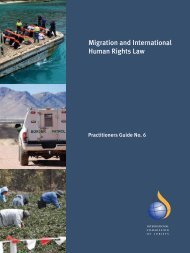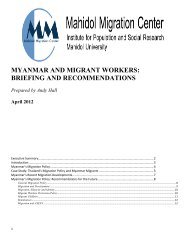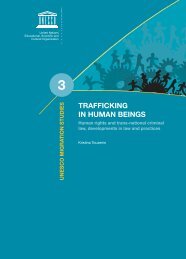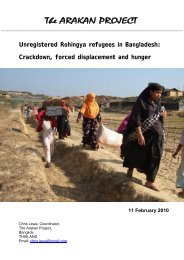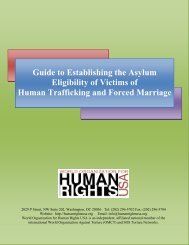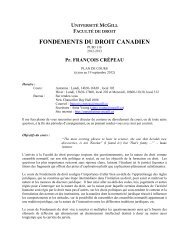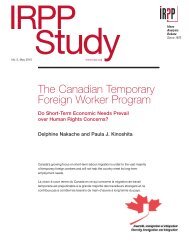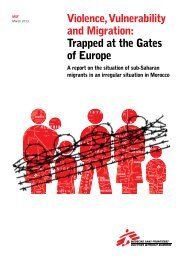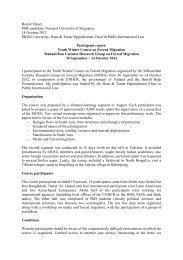Access to Justice for Migrant Workers in BC - West Coast Domestic ...
Access to Justice for Migrant Workers in BC - West Coast Domestic ...
Access to Justice for Migrant Workers in BC - West Coast Domestic ...
You also want an ePaper? Increase the reach of your titles
YUMPU automatically turns print PDFs into web optimized ePapers that Google loves.
which is dependent upon work location and the size of the family unit. 41 Unlike migrants<br />
who come <strong>in</strong> under the O, A and B categories, workers <strong>in</strong> the C and D categories are not<br />
able <strong>to</strong> br<strong>in</strong>g their families <strong>to</strong> Canada until they have obta<strong>in</strong>ed permanent residence. As<br />
such when calculat<strong>in</strong>g whether they meet the <strong>in</strong>come threshold, they are not able <strong>to</strong> use<br />
the <strong>in</strong>come of a spouse <strong>to</strong> supplement their <strong>in</strong>come. This is <strong>in</strong> direct contrast <strong>to</strong> O, A and B<br />
category migrants who are able <strong>to</strong> br<strong>in</strong>g their spouses <strong>in</strong> on open work permits.<br />
As such the <strong>BC</strong> PNP offers limited options <strong>for</strong> NOC C or D workers <strong>to</strong> achieve<br />
permanent residency. The scheme is employer driven and is limited <strong>to</strong> a small number of<br />
occupations or remote regions. Even if applicants f<strong>in</strong>d employers who are will<strong>in</strong>g <strong>to</strong><br />
nom<strong>in</strong>ate them, they have <strong>to</strong> ensure that they ma<strong>in</strong>ta<strong>in</strong> legal immigration status throughout<br />
the process and they have <strong>to</strong> prove that they are able <strong>to</strong> successfully establish themselves<br />
economically <strong>in</strong> Canada. They are also the mercy of their employer because the <strong>BC</strong> PNP<br />
application is jo<strong>in</strong>tly made by the employer and employee. <strong>Workers</strong> who lose employment<br />
dur<strong>in</strong>g the PNP process will be considered <strong>in</strong>eligible <strong>for</strong> PR unless they can f<strong>in</strong>d another<br />
eligible employer and can persuade <strong>BC</strong> PNP <strong>to</strong> transfer the nom<strong>in</strong>ation <strong>to</strong> a new employer.<br />
The Demand <strong>for</strong> <strong>Migrant</strong> Labour <strong>in</strong> British Columbia<br />
In the <strong>BC</strong> Labour Market Outlook 2010-2020 it is projected that there will be 1.03<br />
million projected job open<strong>in</strong>gs <strong>in</strong> <strong>BC</strong> (<strong>in</strong>clud<strong>in</strong>g both expansion and replacement<br />
demand). Reflect<strong>in</strong>g <strong>BC</strong>’s demographic shift <strong>to</strong> an ag<strong>in</strong>g population, it is expected that the<br />
number of new labour market entrants will steadily decl<strong>in</strong>e throughout the outlook period.<br />
Demand <strong>for</strong> workers is expected <strong>to</strong> grow by an annual average rate of 1.4% and the<br />
number of workers needed <strong>in</strong> <strong>BC</strong>’s seven development regions is expected <strong>to</strong> exceed the<br />
number of workers available prov<strong>in</strong>ce-wide. In light of this, it is projected that <strong>BC</strong><br />
employers will rely more heavily on migrants, <strong>in</strong>clud<strong>in</strong>g temporary migrant workers, <strong>to</strong><br />
provide new labour over the next seven years. <strong>Migrant</strong>s, both from outside the prov<strong>in</strong>ce as<br />
well as other countries, are there<strong>for</strong>e an <strong>in</strong>creas<strong>in</strong>gly important source of new labour<br />
supply. As a result of this, it is expected that new migrants <strong>to</strong> <strong>BC</strong> will fill one-third of all job<br />
open<strong>in</strong>gs <strong>in</strong> the prov<strong>in</strong>ce by 2020. 42 Accord<strong>in</strong>g <strong>to</strong> Work <strong>BC</strong>, 22% of all job open<strong>in</strong>gs <strong>in</strong> <strong>BC</strong><br />
between the years 2010-2020 are expected <strong>to</strong> be <strong>for</strong> NOC C and D ‘lower-skill’<br />
positions. 43<br />
A 2011 CIC Facts and Figures reports the <strong>to</strong>tal entries of <strong>for</strong>eign workers <strong>in</strong> <strong>BC</strong> <strong>to</strong>taled<br />
just over 20,000 <strong>in</strong> 2002; by 2006 these numbers had risen <strong>to</strong> 31,013 and then jumped <strong>to</strong><br />
41<br />
“Ability <strong>to</strong> become economically established <strong>in</strong> <strong>BC</strong>,” Welcome <strong>BC</strong>, accessed July 10, 2013, http://www.welcomebc.ca/<br />
Immigrate/immigrate/Prov<strong>in</strong>cial-Nom<strong>in</strong>ee-Program-Home/Strategic-Occupations-Home/Ability-<strong>to</strong>-Become-Economically-<br />
Established-<strong>in</strong>-B-C.aspx.<br />
42<br />
British Columbia. Work <strong>BC</strong>, <strong>BC</strong> Labour Market Outlook 2010-2020, (2010):2-4.<br />
43<br />
British Columbia. Work <strong>BC</strong>, <strong>BC</strong> Labour Market Outlook 2010-2020, (2010): 9.<br />
16




